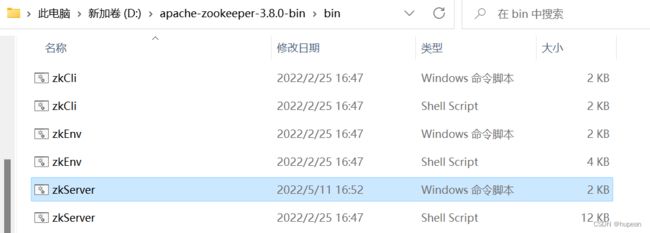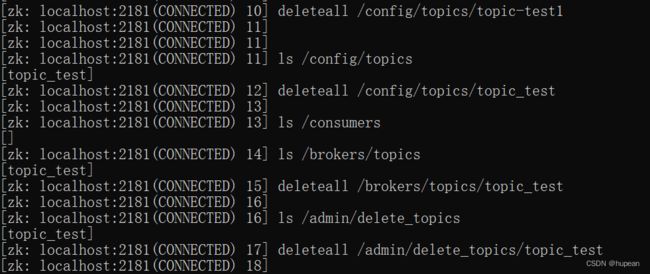Windows下安装并运行kafka
一、安装步骤
- 1.安装JDK
- 2.安装zookeeper
- 3.安装kafka
-
- 3.1kafka常用操作
1.安装JDK
略
2.安装zookeeper
1.下载安装包
地址:http://zookeeper.apache.org/releases.html#download

2、 解压并进入ZooKeeper目录,如:D:\apache-zookeeper-3.8.0-bin\conf
3、 将zoo_sample.cfg重命名为zoo.cfg(也可以复制一份出来)

4、 打开zoo.cfg找到并编辑
tickTime=10000 //默认值2000,可以适当增大
dataDir=D:\apache-zookeeper-3.8.0-bin\data //解压后的zookeeper的data路径
clientPort=2181 //zk端口,按需修改。本例采用默认2181端口
5、 添加系统变量:ZOOKEEPER_HOME=D:\apache-zookeeper-3.8.0-bin

6、 编辑path系统变量,添加路径:;%ZOOKEEPER_HOME%\bin;

7、 bin目录下,双击zkServer脚本运行Zookeeper


命令行提示如上,代表zookeeper启动成功。命令窗口不要关闭,关闭命令窗口会让zk服务也停止掉。
3.安装kafka
1、下载安装包。建议下载低版本的二进制版本(如2.12)
http://kafka.apache.org/downloads

解释:
Source download :源码,还没有编译。下载下来需要自己编译。不推荐下载
Binary downloads: 二进制版本,已经编译好的。推荐下载此版本
2、 解压并进入Kafka目录,笔者:D:\kafka_2.12-2.6.2\kafka_2.12-2.6.2
建议路径不要太长,防止启动kafka时报命令太长而导致无法启动
3、 进入config目录找到文件server.properties并打开
4、 找到并修改下面几项
#修改配置
listeners = PLAINTEXT://your.host.name:9092 //kafka的ip和端口。取消注释,并将your.host.name改成本机ip,如localhost
log.dirs=D:/kafka_2.13-3.2.1/kafka-logs // kafka的日志目录
zookeeper.connect=localhost:2181 // kafka连接的zookeeper的地址
# Licensed to the Apache Software Foundation (ASF) under one or more
# contributor license agreements. See the NOTICE file distributed with
# this work for additional information regarding copyright ownership.
# The ASF licenses this file to You under the Apache License, Version 2.0
# (the "License"); you may not use this file except in compliance with
# the License. You may obtain a copy of the License at
#
# http://www.apache.org/licenses/LICENSE-2.0
#
# Unless required by applicable law or agreed to in writing, software
# distributed under the License is distributed on an "AS IS" BASIS,
# WITHOUT WARRANTIES OR CONDITIONS OF ANY KIND, either express or implied.
# See the License for the specific language governing permissions and
# limitations under the License.
# see kafka.server.KafkaConfig for additional details and defaults
############################# Server Basics #############################
# The id of the broker. This must be set to a unique integer for each broker.
broker.id=0
############################# Socket Server Settings #############################
# The address the socket server listens on. It will get the value returned from
# java.net.InetAddress.getCanonicalHostName() if not configured.
# FORMAT:
# listeners = listener_name://host_name:port
# EXAMPLE:
# listeners = PLAINTEXT://your.host.name:9092
listeners=PLAINTEXT://localhost:9092
# Hostname and port the broker will advertise to producers and consumers. If not set,
# it uses the value for "listeners" if configured. Otherwise, it will use the value
# returned from java.net.InetAddress.getCanonicalHostName().
#advertised.listeners=PLAINTEXT://your.host.name:9092
# Maps listener names to security protocols, the default is for them to be the same. See the config documentation for more details
#listener.security.protocol.map=PLAINTEXT:PLAINTEXT,SSL:SSL,SASL_PLAINTEXT:SASL_PLAINTEXT,SASL_SSL:SASL_SSL
# The number of threads that the server uses for receiving requests from the network and sending responses to the network
num.network.threads=3
# The number of threads that the server uses for processing requests, which may include disk I/O
num.io.threads=8
# The send buffer (SO_SNDBUF) used by the socket server
socket.send.buffer.bytes=102400
# The receive buffer (SO_RCVBUF) used by the socket server
socket.receive.buffer.bytes=102400
# The maximum size of a request that the socket server will accept (protection against OOM)
socket.request.max.bytes=104857600
############################# Log Basics #############################
# A comma separated list of directories under which to store log files
log.dirs=D:/kafka_2.13-3.2.1/kafka-logs
# The default number of log partitions per topic. More partitions allow greater
# parallelism for consumption, but this will also result in more files across
# the brokers.
num.partitions=1
# The number of threads per data directory to be used for log recovery at startup and flushing at shutdown.
# This value is recommended to be increased for installations with data dirs located in RAID array.
num.recovery.threads.per.data.dir=1
############################# Internal Topic Settings #############################
# The replication factor for the group metadata internal topics "__consumer_offsets" and "__transaction_state"
# For anything other than development testing, a value greater than 1 is recommended to ensure availability such as 3.
offsets.topic.replication.factor=1
transaction.state.log.replication.factor=1
transaction.state.log.min.isr=1
############################# Log Flush Policy #############################
# Messages are immediately written to the filesystem but by default we only fsync() to sync
# the OS cache lazily. The following configurations control the flush of data to disk.
# There are a few important trade-offs here:
# 1. Durability: Unflushed data may be lost if you are not using replication.
# 2. Latency: Very large flush intervals may lead to latency spikes when the flush does occur as there will be a lot of data to flush.
# 3. Throughput: The flush is generally the most expensive operation, and a small flush interval may lead to excessive seeks.
# The settings below allow one to configure the flush policy to flush data after a period of time or
# every N messages (or both). This can be done globally and overridden on a per-topic basis.
# The number of messages to accept before forcing a flush of data to disk
#log.flush.interval.messages=10000
# The maximum amount of time a message can sit in a log before we force a flush
#log.flush.interval.ms=1000
############################# Log Retention Policy #############################
# The following configurations control the disposal of log segments. The policy can
# be set to delete segments after a period of time, or after a given size has accumulated.
# A segment will be deleted whenever *either* of these criteria are met. Deletion always happens
# from the end of the log.
# The minimum age of a log file to be eligible for deletion due to age
log.retention.hours=168
# A size-based retention policy for logs. Segments are pruned from the log unless the remaining
# segments drop below log.retention.bytes. Functions independently of log.retention.hours.
#log.retention.bytes=1073741824
# The maximum size of a log segment file. When this size is reached a new log segment will be created.
log.segment.bytes=1073741824
# The interval at which log segments are checked to see if they can be deleted according
# to the retention policies
log.retention.check.interval.ms=300000
############################# Zookeeper #############################
# Zookeeper connection string (see zookeeper docs for details).
# This is a comma separated host:port pairs, each corresponding to a zk
# server. e.g. "127.0.0.1:3000,127.0.0.1:3001,127.0.0.1:3002".
# You can also append an optional chroot string to the urls to specify the
# root directory for all kafka znodes.
zookeeper.connect=localhost:2181
# Timeout in ms for connecting to zookeeper
zookeeper.connection.timeout.ms=18000
############################# Group Coordinator Settings #############################
# The following configuration specifies the time, in milliseconds, that the GroupCoordinator will delay the initial consumer rebalance.
# The rebalance will be further delayed by the value of group.initial.rebalance.delay.ms as new members join the group, up to a maximum of max.poll.interval.ms.
# The default value for this is 3 seconds.
# We override this to 0 here as it makes for a better out-of-the-box experience for development and testing.
# However, in production environments the default value of 3 seconds is more suitable as this will help to avoid unnecessary, and potentially expensive, rebalances during application startup.
group.initial.rebalance.delay.ms=0
5、 Kafka会按照默认,在本机的9092端口上运行,并连接zookeeper的默认端口:2181
6、 进入Kafka安装目录D:\kafka_2.12-2.6.2\kafka_2.12-2.6.2,按下Shift+右键,选择 “在终端中打开” 选项,打开命令行,执行以下命令启动kafka:
.\bin\windows\kafka-server-start.bat .\config\server.properties
注:执行脚本在kafka_2.12-2.6.2\bin\windows目录下,如果kafka已经启动,可以执行以下命令停止kafka
.\bin\windows\zookeeper-server-stop.bat
kafka安装结束!
3.1kafka常用操作
**启动kafka**
.\bin\windows\kafka-server-start.bat .\config\server.properties
**创建topic**
.\bin\windows\kafka-topics.bat --create --zookeeper localhost:2181 --replication-factor 1 --partitions 1 --topic {这是topic名称}
**查看topic描述**
.\bin\windows\kafka-topics.bat --zookeeper localhost:2181 --describe --topic {topic-test1}
**查看所有topic**
.\bin\windows\kafka-topics.bat --list --zookeeper localhost:2181
**修改topic的分区**
.\bin\windows\kafka-topics.bat --zookeeper 127.0.0.1:2181 --alter --topic {topic-test1} --partitions 2
**删除topic【有坑】**
.\bin\windows\kafka-topics.bat --zookeeper localhost:2181 --delete --topic {topic-test1}
踩坑记录:
1.delete命令删除topic后在查看topic,显示marked for deletion,并没有真的删除掉

解决方案:
①在kafka的server.properties中添加delete.topic.enable=true
②打开zookeeper安装目录中的zkCli.cmd
依次执行下面的命令:
1.
ls /config/topics
rmr /config/topics/要删除的topic //如果报Command not found rmr,换下面的命令
deleteall /config/topics/要删除的topic // 新版本使用deleteall删除
2.
ls /consumers
ls /brokers/topics
deleteall /brokers/topics/要删除的topic
3.
ls /admin/delete_topics
deleteall /admin/delete_topics/要删除的topic



